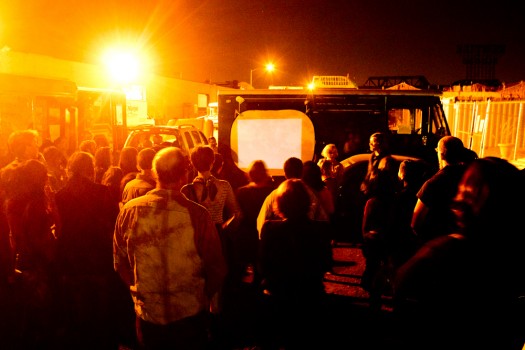
We are celebrating 15 years — and counting — of stories that are deeply researched and deeply felt, that build a historical record of what the city has been.
We are celebrating 15 years — and counting — of stories that are deeply researched and deeply felt, that build a historical record of what the city has been.

Photo by Matthew Caron, yrfriendmatthew.com
On Saturday, October 8, Cinebeasts presented Gowanderlust!, an event combining a neighborhood walking tour with quick, guerilla-style film installations. Just after dusk, a group gathered at the Bell House, a bar in Gowanus, Brooklyn, where we met Nathan Kensinger, photographer, documentary filmmaker, festival programmer and our tour guide for the evening. Kensinger is best known for his work documenting off-limits spaces along the industrial waterfront of New York City. After many years living and working in Gowanus, he knows the neighborhood well and our walk was enlivened by his tales of neighborhood’s politics, environmental issues and urban legends.
Moving towards our first stop, a truck depot at 5th Street and 2nd Avenue, we took a moment to discuss the industrial history of the Gowanus Canal, its designation as a Superfund site and why, unlike many of New York’s other post-industrial waterfront areas, it has yet to be redeveloped (extreme pollution combined with the economic downturn was the group consensus). After a quick turn, we rambled across railroad ties to a vacant lot, the site of our first screening. On a screen tacked to an unsuspecting van, we viewed Silo and Camera Roll for Taylor. Silo is a single-shot time-lapse of ISSUE Project Room at its former location in a converted silo alongside the Gowanus Canal. Camera Roll for Taylor is what director Joel Schlemowitz calls a “camera roll city cine-poem.” Made as a filmic postcard to a friend, Schlemowitz refracted his frames through a crystal, shooting only sites in the vicinity of the canal.
Our second stop landed us just across from Dykes Lumber Yard on 6th Street between 2nd and 3rd Avenues. Projected just below the Dykes sign, we viewed SSS by Henry Hills. Shot in 1988, the film is composed of footage of instances of dance-like spontaneous movement in the streets of the East Village. SSS provoked conversation about ways to inhabit and appropriate under- and un-used urban space — and, it turns out, the film was the inspiration for the Gowanderlust event.
Our third stop landed us across from The Old American Can Factory, at 3rd Street and 3rd Avenue, facing a long abandoned landmarked building. Built in 1872-3, the Coignet Stone Company building was built entirely of cast concrete as a prototype to demonstrate the material’s versatility. The building sits at the edge of what was once an industrial park and is now an expansive, locally-infamous vacant lot. It has housed squatters, provided space and inspiration to artists, been termed a part of “Brooklyn’s biggest toxic playground,” and is now owned by the Whole Foods Company. Projected onto the doors of the Coignet building, we viewed Autumn Leaves, a short film by Brooklyn-based artist Donna Cameron. Cameron uses a unique method that combines photo emulsion and paper to create her work. In Autumn Leaves, she recreates the beauty of autumn by ripping, tearing and rustling the papers, simulating both the sounds and appearance of falling leaves.
A short walk across the 3rd Street Bridge brought us to our fourth stop, at the edge of the canal by the Gowanus Dredgers’ boat launch. Founded in 1999, the Gowanus Dredgers Canoe Club is dedicated to providing waterfront access and education along the canal and throughout other waterfront communities in Brooklyn. Just next to the launch site, we screened our final film, Kevin T. Allen’s What the Sea Left Behind. Depicting a “journey above and below one of America’s most polluted waterways,” Allen used a homemade hydrophone and binaural contact microphones to record the sounds of a canoe on the canal.
On our way back to Cabinet magazine’s offices for a final slideshow and some Brooklyn Brewery brew, we took a break on the Carroll Street Bridge. Built in 1888, it is the oldest retractile bridge in the United States. Instead of rising up, the bridge swings to the bank to allow oncoming boats to pass. From the silo in Joel Schelmowitz’s film to the vacant lands and, of course, the canal itself, the view from the bridge perfectly linked all the pieces of our walk together and offered us a moment to discuss the past and the future of the canal and Gowanus.
Hosting everything from off-the grid communes turned drug houses, to houseboat pioneers, to innovative work spaces, to dumpster swimming pools, post-industrial Gowanus has acted as a refuge for the artistic and the eccentric, for the communal enthusiast and the anarchist. And so, the days when the police would comb the canal for bodies, and the density of toxic waste would cause the canal to self-ignite now seem both long gone and not so long gone. With a massive rezoning complete, construction and development efforts stalled, and the Superfund clean up just beginning, I was left wondering what the future will hold for Gowanus. Are the days of dumpster pools and guerrilla film exhibitions on their way out, soon to be replaced by condos and nondescript commercial development? Or, thanks to the economy, are they just warming up?
The views expressed here are those of the author only and do not reflect the position of Urban Omnibus editorial staff or the Architectural League of New York.
The views expressed here are those of the authors only and do not reflect the position of The Architectural League of New York.